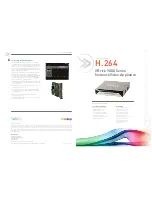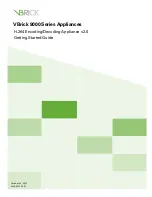
5. SM40 MODULES
5-23
5
5.6
Control Relay Card - CRC
LBB 1356
Eurocard 10 x 22 cm with an ‘a b’ connector (2 x 32) containing 8 make and 8 break contacts to activate
e.g. loudspeaker volume control override relays and ‘priority’ inputs of the SQ45 amplifier range. The
contacts are activated by the CPC via the communication line.
The SQ45 amplifiers (used with the SM40 Centre) are unique in having a ‘music’ input (with preset
sensitivity) and a ‘priority’ input. When used with the SM40 Centre, both these inputs are wired in parallel.
When an announcement or alarm signal is routed to an SQ45 amplifier, the break contacts of the CRC
deactivate the amplifier’s relay, effectively overriding the in-built attenuator (which may have been preset for
broadcasting music at a reduced level). This allows the call or alarm signal to come through at its full level.
When the announcement or signal is finished, the relay will again be activated; the music will be routed to
the amplifier, and will resume at the level it was set at before the interruption.
Control Relay Card (CRC) LBB 1356 has 8 ‘break’ contacts, which deactivate up to 8 SQ45 input relays.
The card also contains 8 ‘make’ contacts to activate up to 8 loudspeaker volume override relays.
These loudspeaker relays override the volume control setting of the actual loudspeaker itself, so that
regardless of the individual volume setting of each loudspeaker, all the loudspeakers in that zone will work at
full volume when a Call is routed to it.
A maximum of 16 CRCs may be used in an SM40 system. 8 of which are related to a column of Matrix
Cards (MC)s. Each pair of the CRC’s make and break relays are ‘locked’ by means of the Function Switch
(position a-c) to 1 of the columns 8 outputs, so that when a call station is routed to that output these relays
will be automatically activated.
A CRC’s position in the system, and the way in which it relates to the Matrix Card columns, is defined by
the “address” it is given. This address setting is accomplished by repositioning a jumper on the Control
Relay Card itself.
Note:
In a 32 x 32 matrix system, CRC L-5 to CRC L-8 have the same function as CRC U-4 to CRC U-8.
The relationship between Matrix Cards and Control Relay Cards is more easily understood by referring to
the accompanying diagrams.
With the CRC’s function switch in the ‘unlocked’ (U) state (position a-b), a number of extra functions
become available:
CRC U-1
Relay set 1 is activated when a system error occurs. This could be used, for instance, to switch on
a remote warning lamp, or personal pager. Relay sets 2 to 8 are not yet used.
CRC U-2
These relays are activated by the CPC’s built-in clock. Ten blocks of time can be designated for
each relay, which may be used to both switch on and to route Auxiliary sources via the matrix (Time related
switching and routing).
CRC U-3
These relays are activated by the CPC’s built-in clock; each relay being activated and deactivated
up to 10 times per day. Days of the week are also selectable.
CRC U-4, 5, 6, 7, 8
These relays can be programmed via the User or Installer menu to be activated by
Call Station user keys. They can be used for ‘output’ routing; i.e. activating power relays at the outputs of
the amplifiers. By activating power relays in this way one large amplifier can be used to selectively feed a
number of different loudspeaker groups. This is additional to input routing, which is done via the matrix, at
the input of the amplifiers.
This function can be used in a maximum system, when extra routing is required.
A yellow LED on the front edge of the card advises that the CRC is in communication with the Central
Processor Card (CPC) and 3 green LEDs indicate that adequate supply voltage is present.
Note:
The maximum current per relay is rated at 1 Amp. AC or DC.
Summary of Contents for LBB 1330
Page 2: ......
Page 4: ...SM40 SOUND DISTRIBUTION SYSTEM ii This page has been left blank intentionally ...
Page 6: ...1 GENERAL INTRODUCTION AND OPERATING PRINCIPLES 1 ...
Page 8: ...1 GENERAL INTRODUCTION AND OPERATING PRINCIPLES 1 2 1 ...
Page 10: ...1 GENERAL INTRODUCTION AND OPERATING PRINCIPLES 1 4 1 ...
Page 12: ...2 UNPACKING AND INSTALLATION 2 ...
Page 16: ...3 SM 40 BASIC SYSTEM AND EXTENSION FRAME 3 ...
Page 18: ...3 SM 40 BASIC SYSTEM AND EXTENSION FRAME 3 2 3 ...
Page 20: ...3 SM 40 BASIC SYSTEM AND EXTENSION FRAME 3 4 3 ...
Page 21: ...3 SM 40 BASIC SYSTEM AND EXTENSION FRAME 3 5 3 ...
Page 22: ...4 OPERATING AND PROGRAMMING THE SM40 SYSTEM 4 ...
Page 60: ...5 SM40 MODULES 5 ...
Page 64: ...5 SM40 MODULES 5 4 5 ...
Page 66: ...5 SM40 MODULES 5 6 5 ...
Page 68: ...5 SM40 MODULES 5 8 5 ...
Page 70: ...5 SM40 MODULES 5 10 5 ...
Page 77: ...5 SM40 MODULES 5 17 5 This page has been left blank intentionally ...
Page 78: ...5 SM40 MODULES 5 18 5 b a c ...
Page 80: ...5 SM40 MODULES 5 20 5 IMPORTANT Ensure the interconnection cable is positioned correctly ...
Page 81: ...5 SM40 MODULES 5 21 5 ...
Page 82: ...5 SM40 MODULES 5 22 5 ...
Page 84: ...5 SM40 MODULES 5 24 5 ...
Page 85: ...5 SM40 MODULES 5 25 5 ...
Page 86: ...5 SM40 MODULES 5 26 5 ...
Page 88: ...5 SM40 MODULES 5 28 5 ...
Page 90: ...5 SM40 MODULES 5 30 5 ...
Page 92: ...5 SM40 MODULES 5 32 5 ...
Page 94: ...5 SM40 MODULES 5 34 5 ...
Page 96: ...5 SM40 MODULES 5 36 5 ...
Page 97: ...5 SM40 MODULES 5 37 5 ...
Page 98: ...5 SM40 MODULES 5 38 5 Surveillance Message Switch Card ...
Page 100: ...5 SM40 MODULES 5 40 5 ...
Page 101: ...5 SM40 MODULES 5 41 5 This page has been left blank intentionally ...
Page 106: ...5 SM40 MODULES 5 46 5 SM40 PHILIPS 6 7 8 9 10 1 2 3 4 5 CALL STATION LBB 9567 ...
Page 108: ...5 SM40 MODULES 5 48 5 ...
Page 110: ...5 SM40 MODULES 5 50 5 ...
Page 112: ...5 SM40 MODULES 5 52 5 ...
Page 113: ...5 SM40 MODULES 5 53 5 ...
Page 114: ...5 SM40 MODULES 5 54 5 ...
Page 115: ...5 SM40 MODULES 5 55 5 ...
Page 116: ...5 SM40 MODULES 5 56 5 ...
Page 117: ...5 SM40 MODULES 5 57 5 ...
Page 118: ...5 SM40 MODULES 5 58 5 ...
Page 120: ...5 SM40 MODULES 5 60 5 This page has been left blank intentionally ...
Page 135: ...6 REMOTE PROGRAMMING 1 O PROTOCOL 6 15 6 This page has been left blank intentionally ...
Page 139: ......
















































